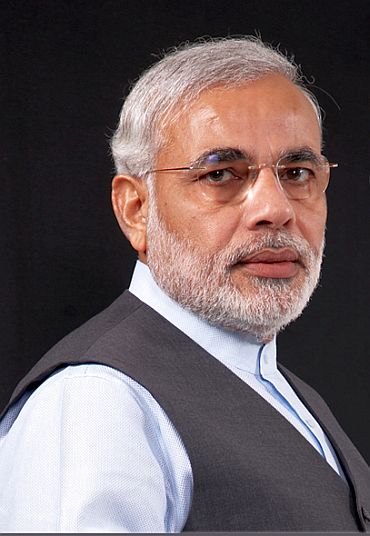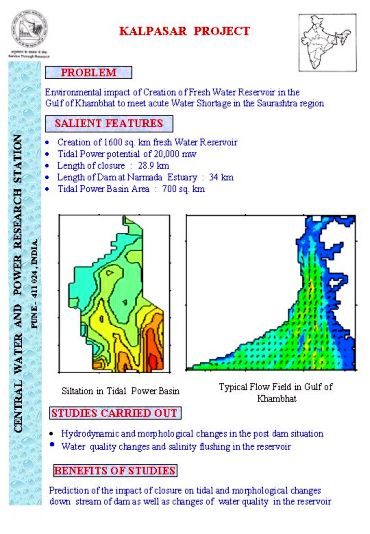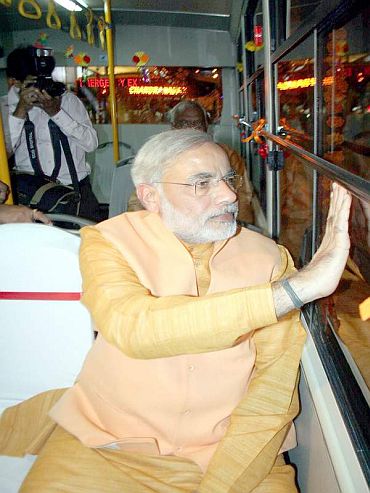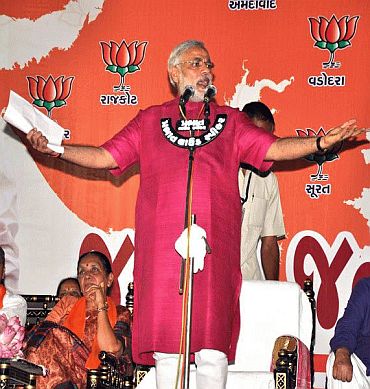 | « Back to article | Print this article |
Why Modi's Rs 54,000 cr legacy project is doomed
Modi's hankering for illusory legacy in the Kalpsar mega water project could prove disastrous for the state's environment and economy, writes activist Himanshu Thakkar
Gujarat Chief Minister Narendra Modi may love it when called Chhote Sardar. But he has been hankering for a project that will leave behind a legacy that matches size of his self-portrait, cannot be chhote (small).
So the project has to be big and it preferably should be a water project.
Sardar Sarovar cannot fit that bill, there are too may other claimants for it and it is too costly, controversial and crisis ridden. Sujalam Sufalam (to solve the water woes of north Gujarat) that Modi started has left largely a legacy of corruption.
One likely candidate for such a legacy project that Modi has been eyeing for long is the Kalpsar Project.
It is indeed a humungous project, larger than anything India has ever undertaken. In fact it is also proposed to be one of the biggest in the world. The basic proposal (the latest version, the versions have been changing pretty rapidly) is to construct a 30 km long dam (one of the longest in the world) across the Gulf of Khambhat between Bharuch and Bhavnagar districts.
Click on NEXT to read why this project is doomed...
The project will create 2,000 sq km reservoir
It is expected to create a reservoir of 2,000 sq km area, over five times the area of Sardar Sarovar, the reservoir capacity is expected to be over 10 billion cubic meters, that is larger than the SSP reservoir capacity.
The water from the reservoir whose level is expected to move between 5 metres above mean sea level and 5 metres below mean sea level and is supposed to be pumped over the height of 65 metres to feed a 15,000 cusec canal that is going to be 660 km long, the longest canal of India.
The reservoir is supposed to trap the water of twelve rivers that empty their water in the gulf, including Narmada, Mahi, Sabarmati, Dhadar and some Saurashtra rivers.
Its claimed benefits include providing irrigation to 10 lakh hectares, reclamation of saline land, generation of tidal power, reducing road distance between south Gujarat and Saurashtra, tourism, among others.
Nothing of this dimensions have ever been undertaken in India, nor possibly in the world if we look at the objectives of Kalpsar.
No such project has been attempted anywhere in the world
The project has been under study for some years now, the earliest detailed study dates back to 1997. But the studies have been rather patchy and unconvincing, necessitated frequent change in scope of the project. For example, till recently the dam was to be a 64 km long affair, now it has been reduced to 30 km length.
Netherlands has built some longer dikes, but they are basically for protection from sea surge, not to create sweet water reservoir from the sea. Take a look at this statement from the Nethcold website, 'The declining salinity of the water led to high mortality of the flora and fauna in Lake Grevelingen, which was created as a result of the dam. Therefore, in 1978, a sluice gate was constructed in the dam to flush the lake with seawater. The lake has since developed into an important nature conservation area.'
South Korea has built a 33 km long Saemangeum dam project in the Yellow Sea, that has been seen as a huge failure and embarrassment, and it was basically for reclamation of 28000 hectares of land.
It has failed, as no freshwater reservoir could be created and no land could be reclaimed for agriculture as per the original plans
But what Gujarat plans is much bigger and more different than any of these. And Modi seems to be banking on creating a legacy of sorts through this project.
He himself initiated "A survey to determine the boundary of Kalpasar dam" on February 5, 2004. In May 2007 he travelled to South Korea to see for himself the Saemangeum project. More recently he told a journalist that he would like to see Kalpsar as his legacy.
It's another matter that Dr Anil Kane, who considers himself pioneer of sorts to push this project has been trying for many years to somehow ensure some progress on this project.Then what is the problem?
The first big problem is that of hydrological feasibility.
All the rivers that flow into the proposed reservoir area are already dammed and water is over committed from those rivers.
To illustrate, about 80 per cent of the water in the proposed Kalpsar is supposed to come from Narmada river.
Narmada has only 23 million acre feet of water annually, but the Narmada water disputes tribunal has allocated 9 MAF of water to Gujarat, assuming Narmada has 28 MAF water.
And Gujarat has already planned to use about 15-20 MAF water from Narmada considering the command area, cropping patterns and non-agriculture water use pattern planned.
The other big issue
So even the surplus monsoon water from Narmada is not likely to be available for Kalpsar.
The second big issue is that whatever little water flows from these rivers that into Gulf is mostly highly toxic.
There are also serious questions about the geological feasibility of constructing this earth and rock-filled, longest dam in the middle of the surging sea, the foundation is yet to be gauged, the issue of salinity that exists in the gulf water and the soil underneath and how much more will leak into the dam.
The reservoir with shallow depth and huge area will have huge evaporation losses, and pumping water into the canals through 65 metres + height would be hugely energy intensive.
The project will face great environmental objections
The claims of the project generating some 5500 MW tidal energy is very doubtful and feasibility questioned by experts.
The project will also destroy the coastal and deltaic fisheries, wetlands. India, as a signatory of Ramsar convention, cannot destroy coastal wetlands in such vast area without raising international issues, the project will also need clearances under the coastal zone regulations.
The bill of the project is appropriately large, considering the size of the legacy that Narendrabhai wants: Rs 54000 crore as per preliminary estimates.
Modi won't be happy to know though that the ministry of environment and forests' expert appraisal committee on river valley projects declined to approve the terms of reference for the environment impact assessment for the project in September 2010.
The seven-member team from Gujarat, lead by Dr M S Patel, secretary, Kalpsar department that went to ministry for this meeting has been told to come back with a lot more information before even the terms of reference for the project can be sanctioned. As we had written to EAC in July 2010 before the meeting, this failed attempt seemed more like an effort to get some legitimacy for a half baked idea.
Unfortunately, Modi is not going to be deterred
Unfortunately, neither the Gujarat government nor Modi are going to be deterred by this failure.
The ambitious politicians of India have for long been hankering for new temples where they can be worshiped by posterity.
Nehru did realise his mistake of calling mega projects as modern temples in 1958 when he called such hankering as megalomania. But not too many people know this afterthought of Nehru.
Nor do the ambitious politicians like Modi realise that prayers can be offered in a small place of worship as effectively.
Incidentally, one of the many possible things Kalpsar can mean includes Kalpanic Sarovar or imaginary reservoir.
Will this one ever become real is a question that is not going to be answered in Modi's lifetime.
Himanshu Thakkar is convenor of South Asia Network on Dams, Rivers & People






